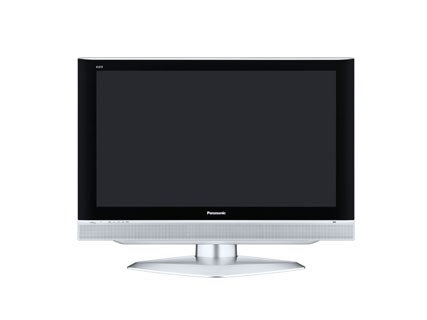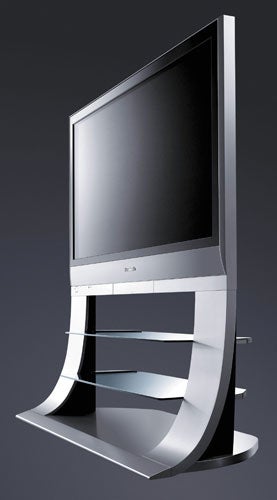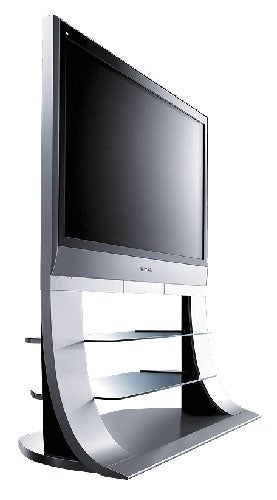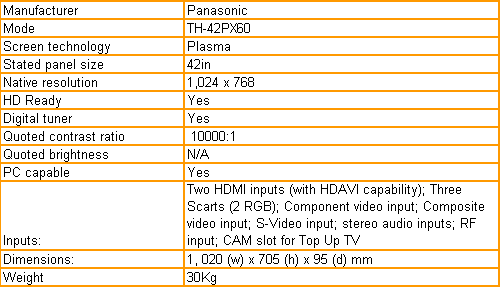Panasonic Viera TH-42PX60B 42in Plasma Review
Panasonic Viera TH-42PX60B 42in Plasma
Panasonic's 42in Viera demonstrates that Plasma isn't letting LCD technology have everything its own way.

Verdict
Key Specifications
- Review Price: £2200.00
When we reviewed Panasonic’s current 32in LCD TV a few days ago, we made the point that Panasonic is one of a dwindling number of companies still sticking to the mantra that while LCD is all well and good for small TVs, plasma is where it’s at for anything big. So we figured we really ought to find out if Panasonic actually has the plasma product to back up its anti-LCD stance.
The 42in Viera TH-42PX60B represents Panasonic’s very latest plasma range – the company’s 9th generation of plasma technology, in fact. But there’s no sign that Panasonic is running out of ideas for, as we’ll discover, the 42PX60 is actually packed to the gunnels with new tricks.
We must start, however, with a backwards step by the 42PX60B. For while it’s by no means ugly, it doesn’t look nearly as attractive as previous Panasonic Viera plasmas as a result of swapping its predecessor’s trademark glossy black screen frame for a much less distinctive plasticky grey. The TV still cuts a great shape if placed on its slenderness-emphasising cabinet, but it’s definitely lost a little glamour.
Connectivity gets things moving back in the right direction by including two HDMI sockets, meaning you can simultaneously attach two next-generation sources – say a Sky high definition receiver and an HD DVD player.
As required by the industry’s HD Ready specifications, the 42PX60B also sports component video inputs for analogue HD sources like the Xbox 360. Plus you get three Scarts, a PC socket, and all the other more basic stuff you’d expect from any self-respecting TV.
As well as being HD Ready, the 42PX60B ticks that other ‘box du jour’ by carrying a built-in digital tuner. And as we’d expect in this day and age, supporting that digital tuner is provision for the full Freeview 7-day electronic programme guide, right down to letting you set timer events simply by selecting them from the listings. The information in the guide is unusually well presented too.
You’re not necessarily restricted to the standard Freeview channel roster either, as the set carries a slot for adding subscription services like Top Up TV.
Now we get to the juicy new stuff, starting with something Panasonic calls HDAVI. This is essentially a fancy new networking system that allows separate bits of compatible kit to talk to each other via their HDMI sockets. Great idea though this is, however, HDAVI does have a fairly major limitation in that it only works with Panasonic kit. So you can’t, say, have the 42PX60B chatting merrily away with a Philips DVD recorder. Oh well – you can’t have everything, we guess.
Perhaps the most significant new development for the 42PX60B is Panasonic’s V-Real image processing system. This brings all manner of new image-boosting tricks to the table, kicking off with the fact that it can work with native 720p or 1080i signals rather than having to downscale them first. Then there’s Digital Remastering for making standard definition pictures look more detailed; gamma control for a richer contrast range; 11.5-bit processing to increase the amount of colour gradations; and a so-called sub-pixel controller that processes the red, green and blue colours independently for each pixel to make edges sharper. 
We’re not done yet, either. For also present in the 42PX60 is a colour management system that processes the colour and luminosity elements of the picture separately to make colours look both more vibrant and more natural. Then there’s a contrast management system that automatically optimises the black level settings depending on the content of the picture. And finally – yes, this really is the last thing you need to get your head round, honest! – Panasonic has added a new Deep Black Filter system to its legendary Real Black Drive technology for boosting black level response. This filter should, reckons Panasonic, cut out ambient light reflections, and in doing so help the 42PX60 achieve a huge claimed contrast ratio of 10,000:1. Eat that, LCD…
You’d expect such an extensive collection of features to add up to one heck of a picture performance. And they do. With knobs on.
The 42PX60’s black levels, for instance, are simply outstanding. There’s not an LCD in the world that can hold a candle to the sheer, grey-free depths of this Panny’s black response. Yet despite their inky blackness, dark parts of the picture are also loaded with the sort of subtle colour details that help make the best flat TV pictures look layered and three dimensional.
Even better, dark parts of the picture are almost entirely bereft of the annoying grey pixel noise that can afflict lesser plasma panels.
The advantages of the 42PX60’s various new colour processing systems are also plain to see, as the full palettes of our favourite movies, PC games and Xbox 360 titles all explode off the screen. Perhaps the biggest sign of the Panasonic’s colour art, however, lies not so much in its vibrancy but in the subtlety of its tones. People’s faces thus avoid the greenness around the gills common with plasma technology, and objects look more solid, as the screen has the dexterity to eke out even the most minute colour blend shifts.
Wrapping up the 42PX60’s superlative pictures is their clarity. High definition films look pin sharp – but so, tellingly, do almost all standard definition sources. This reveals a flexibility in the 42PX60 with different quality sources that’s rare indeed in the usually HD-loving, standard def-hating flat TV world.
A couple of minor issues pull the 42PX60 up short of perfection. First, although HD movies look great, HD games don’t look quite as eye-cuttingly sharp as they can on a good LCD TV. Second, horizontal motion or, especially, camera pans can judder a little rather than crossing your screen smoothly. But that’s it – and you really shouldn’t let these mere trivialities deflect you from the 42PX60’s pictures general majesty.
While not able to hit the same highs as its pictures, the 42PX60’s audio has nothing to be ashamed of. It’s got the raw power to go loud without succumbing to distortion or harshness, voices always sound believable and clear, and trebles are well rounded.
”’Verdict”’
Panasonic’s new plasma might not look quite as hot as its predecessors, but it has got all the connections and features you’ll need together with pictures that are little short of sensational.

How we test televisions
We test every TV we review thoroughly over an extended period of time. We use industry standard tests to compare features properly. We’ll always tell you what we find. We never, ever, accept money to review a product.
Trusted Score
Score in detail
-
Value 9
-
Image Quality 9
-
Sound Quality 8

